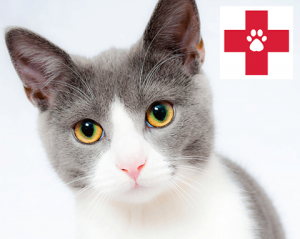It’s a nightmare scenario, and one that many cat owners don’t like to think about – you find your cat, bleeding, or injured, or otherwise in distress. What do you do? 
Most people who find themselves in this situation panic, and run around for a bit, and then rush their cat down to the vets. However, if you think about it in advance, and plan what you need to do, you can dramatically improve the chances of a good outcome (which can be defined as a happy pet going home with you at the end!). In addition, there are many situations where appropriate first aid at the time can genuinely save lives.
This is the first in a series of three blogs where we’re going to look at first aid in cats. In Part 1, we’ll look at assessing the situation, and how you can respond appropriately. In Part 2 we’ll talk about what you can right away to maximise their chances of survival, and then in Part 3, we’ll look at some of the more common diseases and conditions that you’ll need to know how to deal with.
First of all, assess the situation!
The primary and vital rule of first aid is do not put yourself in danger. If you become a casualty, you aren’t helping your pet (and you are potentially putting others in danger as they try to rescue you). Of course, what constitutes danger will depend on the situation, but the most common ways people put themselves at risk when trying to help cats include:
- Traffic – running out into traffic because a cat’s been hit isn’t helpful to anyone, as there’s a good chance you’ll be injured! It is better to stop or block the traffic or call the police to do so, before moving into a busy road.
- Water – cats can, in fact, swim really quite well (although most prefer not to!). If your cat is in difficulty in deep water, don’t jump in yourself, but instead try to fish them out with a net, or a branch, or a floating object that they can cling on to.
- Fire – do not run into a burning building to rescue your cat. Instead, tell the Fire Brigade that the cat is in there, and allow them to make the rescue. Many fire appliances now carry cat-sized oxygen masks to allow the firefighters to help as well.
- Electricity – cats do periodically become entangled in electrical wires. If inside the house, if possible make sure that the current is off (for example, by flipping the trip switch or pulling the fuse). If you can’t get to the fuses or the power switch (or either look like they may be unsafe), use a dry, non-conducting object (such as a wooden broomstick – nothing metal!) to untangle them and push the electrical cables away from them. If it is outdoors and is a mains cable (e.g. overhead wires) do NOT approach – call the police and the electrical company immediately.
- The cats themselves – frightened and painful cats often bite and scratch – it isn’t that they want to hurt you, but they can’t help it when they’re scared or hurting. So make sure you’re not injured while trying to help!
Once you have managed to safely reach the injured puss, your next task is to assess their situation. Are they breathing? Is there severe bleeding? What’s going on? At this point, it is often helpful to call us – one of our vets or nurses will be able to walk you through what you need to do over the phone and can prepare to meet you at the surgery.
The first part of your assessment is the primary survey – this is intended to check whether the cat is at imminent risk of death.
- Are they responsive? Are they aware of their surroundings, and (at least semi-) conscious? If yes, move to point 3.
- If not, then (just like human first-aiders), we use the “ABC” model to try and work out why:
- Airway – can the cat move air? If in doubt, try to extend the head and neck and gently pull the tongue out of their mouth. If there’s anything in the mouth, try and hoick it out (without getting bitten).
- Breathing – is the cat breathing? The best way to check this is to hold a clump of fluff in front of their nose and see if it moves. If not, you may need to start CPCR (see Part 2).
- Circulation – is the cat’s heart beating? You can check this by feeling behind the elbow on their left-hand side. If not, you will need to carry out CPCR.
- Are there any other life-threatening injuries? We’re not generally talking about broken bones here (they’re painful but unlikely to be fatal as long as you’re careful). However, severe bleeding, head trauma, and damage to the chest are all potentially lethal. Of these, the only one you can do anything about in the first aid situation is bleeding – you’ll need to try and stop it, or at least slow it down, and then rush them to us for definitive treatment.
In Part 2 we’ll look at what you can do for your cat in an emergency situation. If your cat is suddenly ill or injured, call us for advice!
